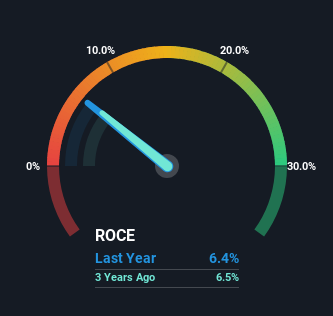Returns On Capital At Kinder Morgan (NYSE:KMI) Have Stalled
Did you know there are some financial metrics that can provide clues of a potential multi-bagger? Typically, we'll want to notice a trend of growing return on capital employed (ROCE) and alongside that, an expanding base of capital employed. This shows us that it's a compounding machine, able to continually reinvest its earnings back into the business and generate higher returns. However, after investigating Kinder Morgan (NYSE:KMI), we don't think it's current trends fit the mold of a multi-bagger.
What Is Return On Capital Employed (ROCE)?
Just to clarify if you're unsure, ROCE is a metric for evaluating how much pre-tax income (in percentage terms) a company earns on the capital invested in its business. The formula for this calculation on Kinder Morgan is:
Return on Capital Employed = Earnings Before Interest and Tax (EBIT) ÷ (Total Assets - Current Liabilities)
0.064 = US$4.2b ÷ (US$71b - US$4.6b) (Based on the trailing twelve months to March 2024).
Thus, Kinder Morgan has an ROCE of 6.4%. Ultimately, that's a low return and it under-performs the Oil and Gas industry average of 13%.
See our latest analysis for Kinder Morgan
In the above chart we have measured Kinder Morgan's prior ROCE against its prior performance, but the future is arguably more important. If you're interested, you can view the analysts predictions in our free analyst report for Kinder Morgan .
What Does the ROCE Trend For Kinder Morgan Tell Us?
Things have been pretty stable at Kinder Morgan, with its capital employed and returns on that capital staying somewhat the same for the last five years. Businesses with these traits tend to be mature and steady operations because they're past the growth phase. With that in mind, unless investment picks up again in the future, we wouldn't expect Kinder Morgan to be a multi-bagger going forward. On top of that you'll notice that Kinder Morgan has been paying out a large portion (90%) of earnings in the form of dividends to shareholders. If the company is in fact lacking growth opportunities, that's one of the viable alternatives for the money.
Our Take On Kinder Morgan's ROCE
In summary, Kinder Morgan isn't compounding its earnings but is generating stable returns on the same amount of capital employed. And with the stock having returned a mere 29% in the last five years to shareholders, you could argue that they're aware of these lackluster trends. So if you're looking for a multi-bagger, the underlying trends indicate you may have better chances elsewhere.
If you'd like to know more about Kinder Morgan, we've spotted 3 warning signs, and 2 of them are a bit concerning.
While Kinder Morgan may not currently earn the highest returns, we've compiled a list of companies that currently earn more than 25% return on equity. Check out this free list here.
Have feedback on this article? Concerned about the content? Get in touch with us directly. Alternatively, email editorial-team (at) simplywallst.com.
This article by Simply Wall St is general in nature. We provide commentary based on historical data and analyst forecasts only using an unbiased methodology and our articles are not intended to be financial advice. It does not constitute a recommendation to buy or sell any stock, and does not take account of your objectives, or your financial situation. We aim to bring you long-term focused analysis driven by fundamental data. Note that our analysis may not factor in the latest price-sensitive company announcements or qualitative material. Simply Wall St has no position in any stocks mentioned.

 Yahoo Finance
Yahoo Finance 
